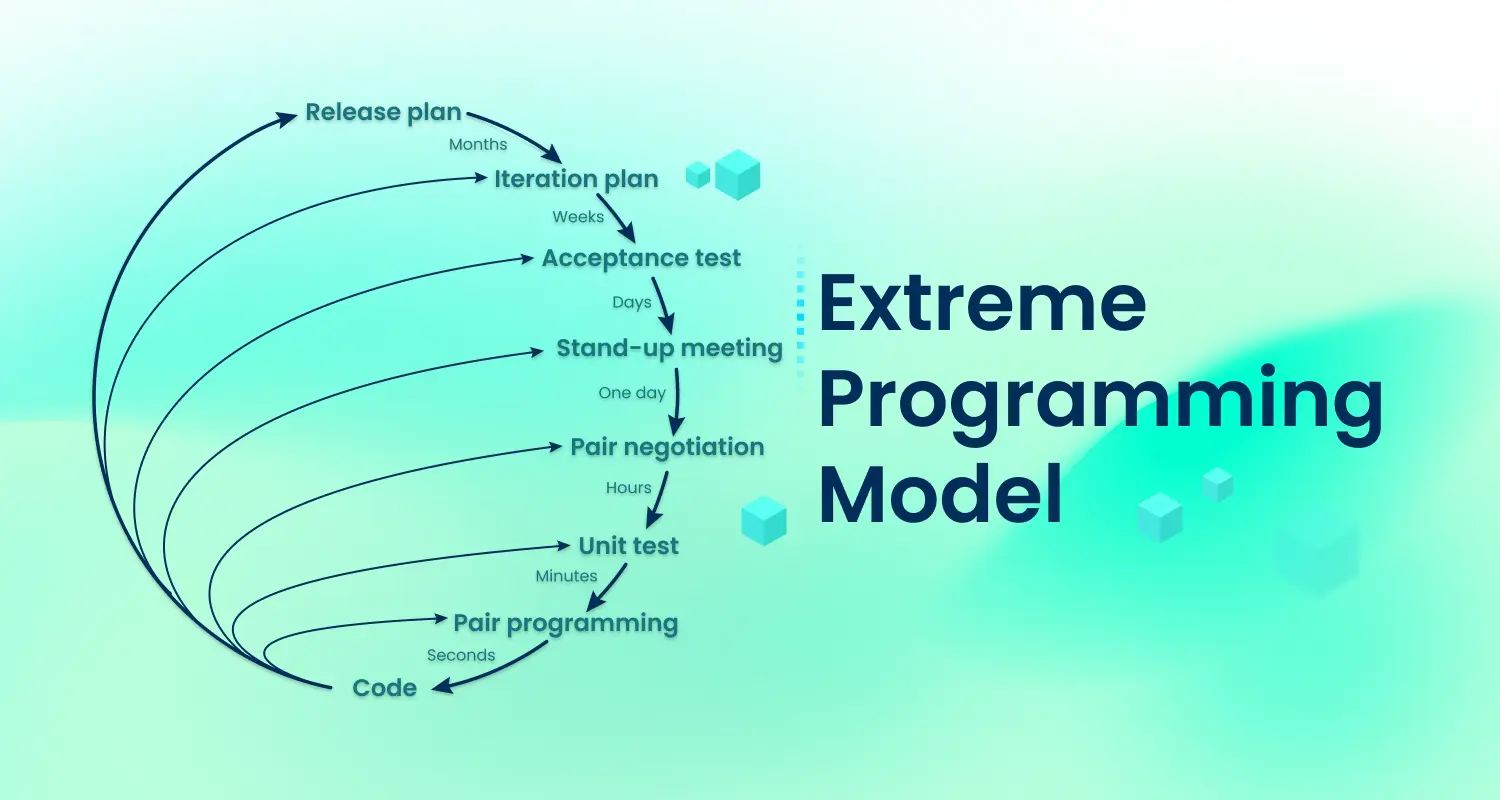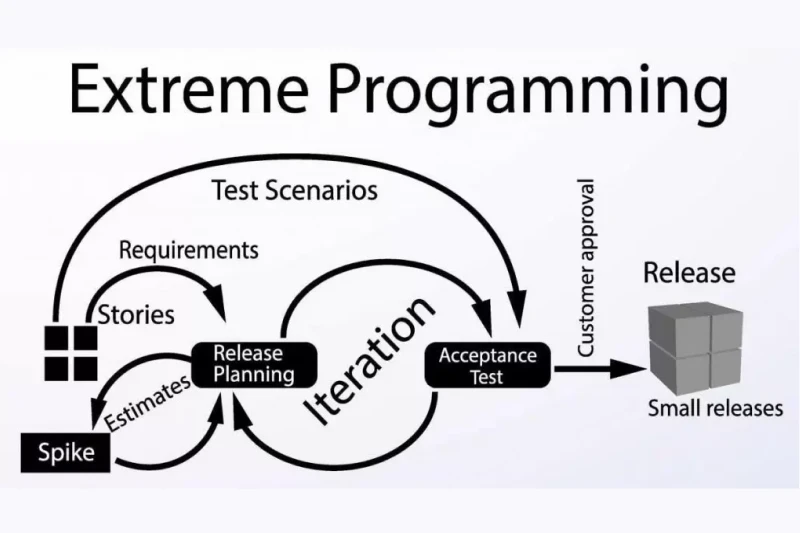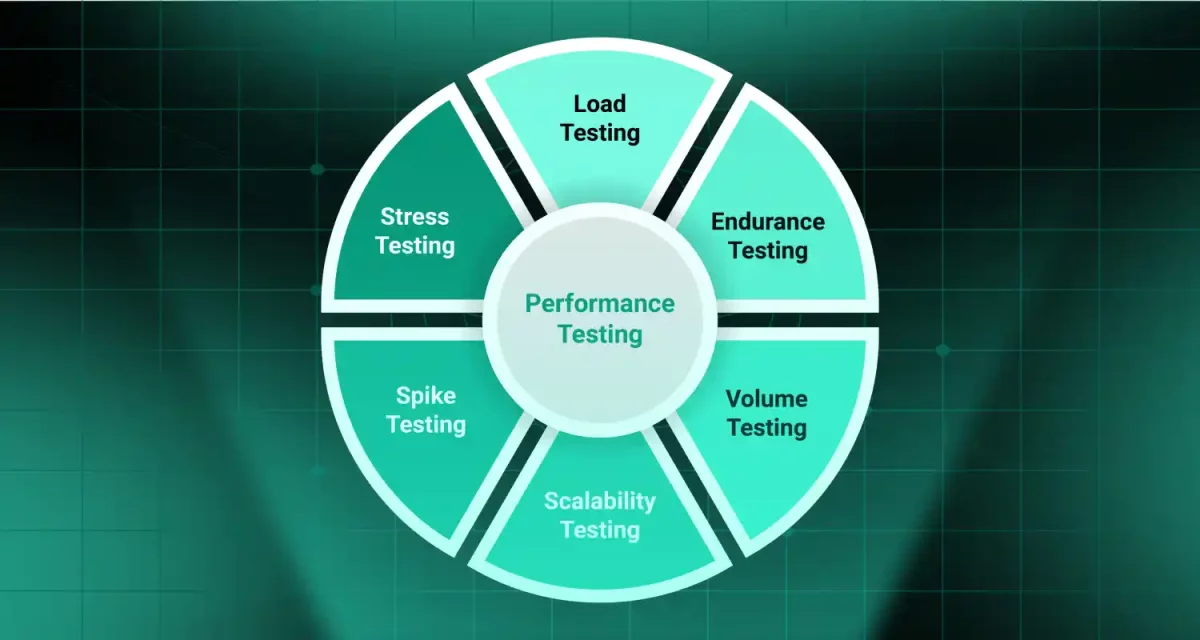
Extreme Programming (XP) is one of the most effective software development methodologies, evolving to meet the ever-changing demands of businesses and technology. Developers constantly seek efficient ways to build high-quality software from traditional waterfall models to modern Agile methodologies.
1. What is Extreme Programming (XP)?
Extreme Programming (XP) is an Agile software development methodology that enhances software quality and responsiveness through frequent releases, customer collaboration, and continuous testing.
Introduced in the late 1990s by Kent Beck, with contributions from Ward Cunningham and Ron Jeffries, XP is based on the principles of the Agile Manifesto. It aims to streamline the software development lifecycle, ensuring adaptability and high performance.
Key objectives of XP
- Deliver high-quality software efficiently.
- Promote teamwork and communication.
- Adapt to changing requirements with minimal friction.
- Encourage continuous learning and improvement.

Read more >>> What is Scrum in Agile software development?
2. Core values of XP
XP is built upon five core values that guide software teams toward successful project execution:
Communication
Frequent and clear communication among team members, customers, and stakeholders ensures alignment and smooth development processes. This open dialogue fosters better collaboration and reduces misunderstandings, leading to efficient decision-making.
Simplicity
Keeping the design as simple as possible minimizes complexity and reduces maintenance overhead. Simple solutions are easier to implement, debug, and extend in the future, aligning with best software engineering methodologies practices.
Feedback
Continuous feedback from customers, developers, and tests ensures the project remains on track and aligned with evolving requirements. This iterative feedback loop enhances adaptability and allows teams to make necessary adjustments quickly.
Courage
Developers must be willing to make necessary changes, eliminate technical debt, and address challenges head-on. Courage also extends to refactoring code, integrating new features, and continuously improving the development process without hesitation.
Respect
A collaborative environment built on mutual respect fosters innovation and teamwork, allowing developers to share ownership and responsibility. Respect ensures that every team member’s contributions are valued, creating a positive and productive work atmosphere.
Need a Tech Partner Who Truly Gets Your Vision?
From strategy to execution, we`ll partner with you throughout development, delivering clarity, confidence, and measurable results. Get your free project estimate today.
Talk to Our ExpertsRead more >>> Shape Up Methodology: A Practical Guide for Software Teams
3. Basic principles of extreme programming
XP incorporates essential principles that drive its effectiveness in agile software development. These Extreme Programming principles and practices are the foundation of methodology:
Iterative development
Short, frequent development cycles with incremental updates ensure continuous progress. By breaking down work into smaller iterations, developers can respond to changes quickly and efficiently.
Customer involvement
Regular engagement with stakeholders provides clarity on requirements and expectations. Customers play an active role in prioritizing features and providing real-time feedback.
Simplicity and flexibility
Prioritizing straightforward solutions prevents unnecessary complexity and ensures adaptability. Simple designs reduce development time and increase maintainability.
4. Practices of extreme programming
4.1. Fine-scale feedback practices
- Pair programming
Collaborative coding, known as pair programming, involves two developers jointly tackling one assignment. One developer, known as the “driver,” writes the code, while the other, the “observer” or “navigator,” reviews each line as it is written.
The two programmers frequently switch roles, ensuring that the code remains high quality and that knowledge is shared effectively. This practice reduces the likelihood of errors, enhances collaboration, and promotes continuous learning within the team.
- Planning game
The Planning Game is an essential Extreme Programming practice involving developers and customers. It is a collaborative approach to planning that helps determine which features should be developed next based on business value and technical feasibility.
Customers outline their desired functionality, while developers estimate the effort required. Together, they prioritize tasks to ensure that the most valuable features are implemented first. This process enables flexibility and ensures the project remains aligned with business objectives.
- Test-driven development (TDD)
A software development approach known as TDD emphasizes the priority of test creation over code development. Developers write a test case defining a specific function or feature.
The test initially fails, prompting the developer to write the minimal code necessary to pass the test. Once the test passes, the code is refined and improved through refactoring. This iterative process ensures software reliability, reduces bugs, and leads to well-structured, maintainable code.
- Whole team approach
The whole team approach promotes collaboration between developers, testers, business analysts, and customers. In XP, every team member is involved in the software development process, ensuring that different perspectives contribute to the final product.
This method fosters open communication, aligns expectations, and accelerates problem-solving. By working together closely, teams can quickly adapt to changes and improve the quality of their software.

Need a Tech Partner Who Truly Gets Your Vision?
From strategy to execution, we`ll partner with you throughout development, delivering clarity, confidence, and measurable results. Get your free project estimate today.
Talk to Our Experts4.2. Continuous process practices
- Continuous integration
Continuous integration (CI) is merging all code changes into a shared repository multiple times a day. Automated tests run against each new code submission, allowing developers to detect and fix issues early.
This practice ensures that the software remains stable and that integration conflicts are minimized. CI promotes rapid development and helps maintain a reliable building throughout the development cycle.
- Design improvement (Refactoring)
Refactoring is the process of improving existing code without changing its functionality. Developers continuously refine the code structure to make it more efficient, readable, and maintainable.
Regular refactoring prevents technical debt from accumulating and ensures that the codebase remains flexible. By keeping the design simple and eliminating redundancies, refactoring contributes to long-term software sustainability.
- Small releases
The software is released in minor, incremental updates in XP rather than in large, monolithic versions. Each release includes functional components that users can test and provide feedback on.
This approach allows developers to identify and address issues quickly, ensuring the software evolves in response to user needs. Minor releases reduce the risk of significant system failures, as each change is tested and validated before deployment.
4.3. Shared understanding practices
- Coding standards
Coding standards ensure consistency in code formatting, naming conventions, and documentation across a project. Adhering to coding standards improves code readability, simplifies maintenance, and reduces misunderstandings between team members. In XP, teams define and follow coding standards to maintain high-quality code throughout development.
- Collective code ownership
Collective code ownership allows all team members to contribute to and modify any part of the codebase. This approach ensures that knowledge is distributed among developers, reducing dependency on specific individuals.
If a developer leaves the project, the team can continue working without disruptions. Collective ownership encourages responsibility and fosters a culture of shared accountability.
- Simple design
XP emphasizes simplicity in software design. A simple design is easier to understand, modify, and extend. It reduces unnecessary complexity and makes debugging more efficient.
Developers can build functional and maintainable systems by focusing on what is essential and avoiding over-engineering.
- System metaphor
A system metaphor is a shared analogy or description that helps team members understand how the software works. For example, comparing software architecture to a “library” with different “sections” can help developers visualize its structure.
Metaphors make communicating technical concepts to non-technical stakeholders easier and maintain a shared understanding within the development team.
4.4. Programmer welfare practices
A sustainable pace, or “40-hours work weeks,” ensures developers maintain a healthy work-life balance. XP discourages excessive overtime, as prolonged work hours lead to burnout and decreased productivity.
By maintaining a steady, manageable workload, developers can remain engaged, motivated, and productive in the long run.
Read more >>> V-Model advantages and disadvantages
5. Advantages of Extreme Programming
Understanding the benefits and challenges of XP is crucial for organizations considering its adoption. While XP offers significant advantages, it also presents unique hurdles that teams must navigate.
- Enhanced customer satisfaction
XP emphasizes continuous customer feedback and involvement. Regular iterations allow customers to see progress and provide input, ensuring that the final product meets their expectations. This approach minimizes miscommunication and increases satisfaction.
- Improved software quality
XP practices like test-driven development, pair programming, and continuous integration enhance software quality. Writing tests before code prevents defects, while collaborative coding ensures well-structured and maintainable code.
- Flexibility and adaptability
XP’s iterative approach makes it highly adaptable to changing requirements. If customers request modifications, developers can incorporate changes without disrupting the entire project. This flexibility is beneficial in dynamic business environments.
- Faster time-to-market
XP enables companies to launch products faster by prioritizing minor releases and frequent iterations. Continuous feedback allows for immediate adjustments, reducing the time spent on rework.
- Reduced costs
Early detection of bugs through TDD and continuous integration reduces costly fixes later in development. Frequent customer involvement also prevents scope creep and unnecessary feature development, optimizing resource allocation.
6. Disadvantages and challenges of XP
- High customer involvement
XP requires constant communication with customers, which can be challenging. If stakeholders are unavailable or unresponsive, it may disrupt the development process.
- Increased initial effort
XP practices such as pair programming and test-driven development require more initial effort. Writing tests before code and frequent refactoring can slow down early development, though they yield long-term benefits.
- Cultural shifts
Teams used to traditional waterfall methodologies may struggle to adapt to XP’s dynamic approach. Organizations must foster an open-minded culture and invest in training to ensure a smooth transition.
- Scaling challenges
XP works best with small to medium-sized teams. Scaling it to large enterprises requires additional coordination, which can introduce complexity.
7. Applications of Extreme Programming
Extreme Programming (XP) is highly effective in fast-moving industries where agility, efficiency, and software quality are critical.
7.1. Key scenarios for extreme programming
Its adaptability makes it well-suited for:
- Projects with constantly changing requirements: Businesses operating in dynamic markets, such as eCommerce, SaaS, and fintech, often need to adjust their software to meet new customer demands. XP allows teams to pivot quickly by incorporating feedback into frequent releases.
- Teams with rapid development cycle: Industries that rely on continuous product updates, such as mobile applications and cloud-based platforms, benefit from XP’s iterative approach. Frequent releases ensure customers receive timely improvements without waiting for large-scale updates.
- Startups and innovative product teams: New businesses must launch quickly, test ideas, and refine their products based on user responses. XP helps startups avoid costly delays by enabling fast prototyping and quick course corrections.
- High-stakes software projects: Applications that require high reliability, such as healthcare systems, banking platforms, and aerospace software, can leverage XP’s test-driven development and continuous integration to reduce errors and enhance stability.
- Distributed or remote development teams: Companies with developers working across locations can use XP practices like pair programming, shared code ownership, and automated testing to maintain quality and consistency.
Want to Integrate Powerful IT Solutions into Your Business?
We provide tailored IT solutions designed to fuel your success. Let`s map out a winning strategy. Starting with a free consultation.
Contact Us7.2. Case studies

- Tesla (Automotive Software): Tesla applied XP methodologies in its vehicle software updates, allowing over-the-air improvements to features like Autopilot and battery optimization. Regular software iterations ensured continuous enhancement of driver experience and vehicle performance.
- Netflix (Streaming Service): Netflix implemented XP principles like continuous integration and test-driven development to ensure seamless content delivery. Automated testing allowed engineers to deploy frequent updates without disrupting user experience.
- Uber (Ride-Sharing Platform): Uber used XP’s iterative development process to enhance its real-time tracking and dynamic pricing algorithms. Minor, frequent updates enabled the company to improve efficiency while adapting to global market demands.
- Instagram (Social Media App): Instagram leveraged XP’s rapid development cycles to introduce new features such as Stories and Reels, testing and refining them based on user engagement data before scaling globally.
These cases highlight XP’s effectiveness across various sectors, proving that its focus on collaboration, adaptability, and continuous improvement benefits both tech startups and large enterprises.
8. Life cycle of an XP project
An XP project follows a structured software development lifecycle:
- Planning phase
- Identifying customer needs, defining user stories, and setting priorities.
- Establishing communication channels between developers and stakeholders.
- Design and coding
- Implementing simple, iterative designs following XP principles.
- Using pair programming to enhance collaboration and code quality.
- Testing and integration
- Applying test-driven development and continuous integration to ensure software reliability.
- Running automated tests and collecting feedback from end-users.
- Release and feedback
- Deploying minor releases and incorporating user feedback for ongoing improvements.
- Monitoring performance and making adjustments as needed.
Implementing XP in software projects involves careful consideration of the entire lifecycle. The planning phase is critical, setting the stage for the rest of the project.
9. Conclusion
Extreme Programming (XP) offers a powerful approach to agile methodologies, ensuring high-quality, adaptable, and efficient software development. While it demands strong team collaboration and continuous engagement, the benefits outweigh the challenges for teams aiming to deliver superior products.
By embracing XP’s values, practices, and principles, organizations can foster innovation, streamline workflows, and enhance customer satisfaction.




